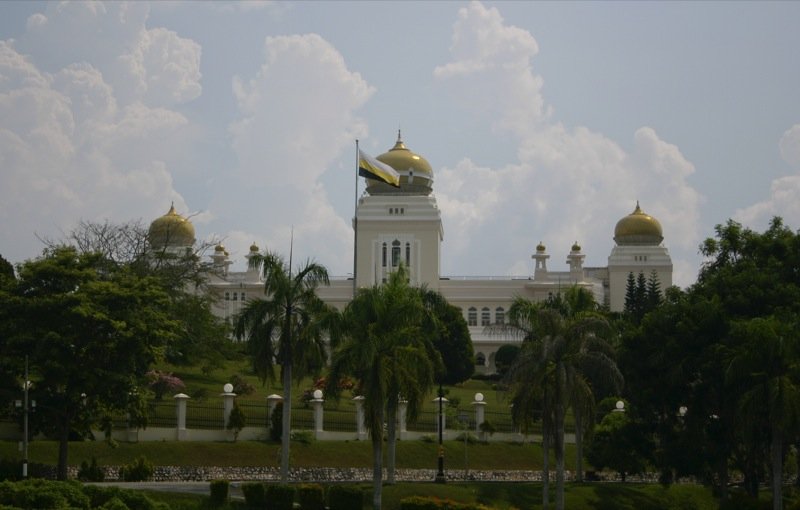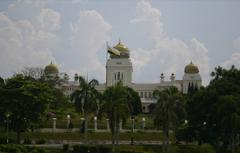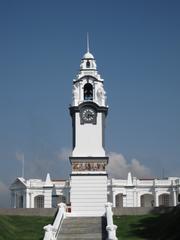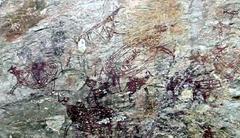
Istana Iskandariah Visiting Guide: Perak, Malaysia – Tickets, Hours, and Tips
Date: 15/06/2025
Introduction: History and Significance
Perched atop Bukit Chandan and overlooking the serene Perak River in Kuala Kangsar, Istana Iskandariah is a resplendent symbol of Malaysia’s royal heritage and architectural sophistication. Commissioned in the early 1930s by Sultan Iskandar Shah, the palace serves as the official residence of the Sultan of Perak and stands as a beacon of the Perak Sultanate’s enduring legacy. Its location, chosen after the devastating 1926 flood, reflects both safety and prominence. Architecturally, Istana Iskandariah is a unique blend of Art Deco, Islamic, and traditional Malay motifs, featuring elegant domes, graceful arches, and intricate woodwork—an embodiment of Malaysia’s multicultural history (Wikipedia; Orang Perak).
While the palace’s interior remains private, its magnificent exterior and lush grounds attract visitors eager to witness Perak’s royal traditions. The palace is also the centerpiece of state ceremonies, underscoring its political and cultural significance (Perak State Government). This guide explores the palace’s storied past, architectural highlights, practical visitor information, and nearby attractions.
Table of Contents
- Introduction: History and Significance
- Historical Background
- Architectural Highlights
- Visiting Hours, Tickets & Practical Tips
- Nearby Historical Sites
- Cultural and Political Significance
- Visitor Experience & Recommendations
- Frequently Asked Questions (FAQ)
- Conclusion and Visitor Recommendations
- References
Historical Background
Early Royal Residences
Before Istana Iskandariah, the Perak royal family resided in palaces such as Istana Sri Sayong, situated on the riverbank. The catastrophic “Big Flood” of 1926 prompted the move to higher ground, ensuring greater safety for the royal household (Wikipedia).
Construction and Purpose
Sultan Iskandar Shah, the 30th Sultan of Perak, initiated the construction of Istana Iskandariah on Bukit Chandan in the late 1920s. The palace was completed in 1933, standing on the site of the former Istana Negara. During its construction, the royal family temporarily resided at Istana Kenangan, now preserved as the Royal Museum of Kuala Kangsar (Orang Perak; Visit Perak).
Royal Seat and Symbolism
Istana Iskandariah has since become the epicenter of Perak’s monarchy, hosting royal investitures and daily royal functions. Every Sultan since its completion has been installed here, further cementing its status as the heart of the Perak Sultanate (Sultan Perak Official). The palace also reflects Kuala Kangsar’s importance during the colonial era, having served as the administrative center for the first British Resident (ExpatGo).
Architectural Highlights
Design and Influences
Istana Iskandariah is a rare example of Art Deco architecture in Malaysia, harmoniously combined with Malay and Islamic design elements. The two-story palace is structured with a central dome, four smaller domes at each corner, and a façade that blends geometric forms with traditional motifs (Wikipedia; The Star). The domes, finished with crescent moon finials, reinforce the palace’s Islamic identity.
Layout and Materials
The palace’s rectangular block faces the river and sunrise, maximizing natural light and ventilation—a testament to traditional Malay architecture adapted for the tropics. The grand staircase, marble flooring, and imported materials such as Italian marble highlight the palace’s opulence (Malaysia.travel). Ornate wood carvings, latticework, and stained-glass windows demonstrate the craftsmanship of local artisans.
Expansion
In 1984, the palace underwent a significant expansion, adding new domes and seamlessly blending with the original structure. The interior comprises ceremonial halls, private quarters, and the Singgahsana (Royal Throne Hall), all adorned with decorative ceilings and gilded moldings (Orang Perak).
Visiting Hours, Tickets & Practical Tips
Visiting Hours
As an active royal residence, Istana Iskandariah’s interior is not open to the public. However, the grounds and exterior can be admired daily from 8:00 AM to 5:00 PM. Special tours or access may be available during royal events or by appointment. Always check official sources for updates.
Tickets
There is no entrance fee to view the palace exterior. Tickets are required for nearby attractions such as the Sultan Azlan Shah Gallery and Istana Kenangan (Royal Museum), which are open daily from 9:00 AM to 5:00 PM.
Travel Tips
- Getting There: Kuala Kangsar is accessible by road from Ipoh (approx. 40–50 km) and by train via KTM. Local taxis and ride-hailing services are available (Wahdah).
- Dress Code: Wear modest attire, especially when visiting religious sites nearby.
- Photography: Exterior photography is permitted; drone and professional photography may require permission.
- Facilities: No public restrooms or refreshments at the palace; use facilities at nearby attractions.
Nearby Historical Sites
- Ubudiah Mosque: Noted for its golden domes and Italian marble, just a short walk from the palace (Trek Zone).
- Al-Ghufran Royal Mausoleum: Resting place of Perak’s sultans, with intricate Mughal-inspired architecture.
- Sultan Azlan Shah Gallery: Houses royal artifacts and memorabilia.
- Istana Kenangan (Royal Museum): Former wooden royal residence, now a museum showcasing Malay architecture (Visit Perak).
Cultural and Political Significance
Istana Iskandariah is a powerful symbol of the Perak Sultanate’s unity and continuity. It serves as the venue for major state ceremonies and royal celebrations, embodying the monarchy’s role as an impartial arbitrator and moral authority (Perak State Government). The palace also supports cultural initiatives, traditional arts, and religious events, reinforcing its role as a custodian of Perak’s heritage.
Visitor Experience & Recommendations
- Best Views: The main gates and perimeter roads offer the best vantage points for photography, especially in the early morning or late afternoon.
- Cultural Immersion: Explore local crafts (Tekat Benang Emas, Labu Sayong) and sample regional cuisine in the town center (Wahdah).
- Heritage Walk: Combine your palace visit with nearby sites for a comprehensive heritage experience.
Frequently Asked Questions (FAQ)
Q: Can visitors enter Istana Iskandariah?
A: No, the palace is not open for public interior tours. The exterior and grounds can be viewed from outside the gates.
Q: Are tickets required?
A: No tickets are needed to view the palace exterior. Tickets are required for entry to nearby museums and galleries.
Q: Are guided tours available?
A: While palace tours are not offered, local heritage tours often include Istana Iskandariah as a highlight (Time Travel Turtle).
Q: Is photography allowed?
A: Yes, for the exterior; always check for restrictions on drone or professional equipment.
Conclusion and Visitor Recommendations
Istana Iskandariah is a must-see for anyone interested in Malaysia’s royal heritage, architecture, and culture. Although access to its interior is restricted, its grandeur, historical significance, and proximity to other landmarks make it a highlight of any Kuala Kangsar itinerary. Plan your visit during the drier months, explore the surrounding historical sites, and immerse yourself in the traditions of the Perak Sultanate.
For the latest visitor information and travel tips, consult official sources or download the Audiala app.
References
- Istana Iskandariah, Wikipedia
- Istana Iskandariah: A Symbol of Perak’s Pride, Orang Perak
- Discover the Varied Marvels of Kuala Kangsar, The Star
- Istana Iskandariah and Kuala Kangsar History, HelloTravel
- Royal Institution of Perak and Istana Iskandariah, Perak State Government
- Kuala Kangsar Attractions, TravelTriangle
- Perak Royal Palace Overview, Visit Perak
- Ajlee Blog
- Trek Zone
- Wahdah
- MyWeekendPlan
- Time Travel Turtle
- ShareTrip
- Malaysia.travel
- Penang Insider
- Sultan Perak Official
- ExpatGo




